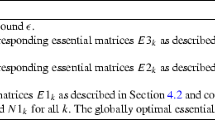Abstract
We present a method seeking correspondences in a dense rectified image sequence, considered as a set of Epipolar Plane Images (EPI). The main idea is to employ dense sequence to get more information which could guide the correspondence algorithm. The method is intensity based, no features are detected. Our spatio-temporal volume analysis approach aims at accuracy and density of the correspondences.
Two cost functions are used, quantifying the belief that given correspondence candidate is correct. The first one is based on projections of one scene point to the spatio-temporal data, while the second one uses two-dimensional neighborhood (in image plane) around such projections. The assumed opaque Lambertian surface without occlusions allows us to use a simple correspondence seeking algorithm based on minimization of a global criterion using dynamic programming.
This research was supported by the Czech Ministry of Education under the project MSM 212300013 and by the Grant Agency of the Czech Republic under the project GACR 102/03/0440 and by the European Union under the project IST-2001-32184.
Access this chapter
Tax calculation will be finalised at checkout
Purchases are for personal use only
Preview
Unable to display preview. Download preview PDF.
Similar content being viewed by others
References
Bolles, R.C., Baker, H.H., Marimont, D.H.: Epipolar plane image analysis: An approach to determining structure from motion. Internation Journal of Computer Vision 1(1), 7–55 (1987)
Chou, G.T.: A model of figure-ground segregation from kinetic occlusion. In: Grimson, E. (ed.) ICCV 1995: Proc. 5th IEEE Intl. Conf. on Computer Vision, Cambridge, Massachusetts, June 1995, pp. 1050–1057. IEEE Computer Society Press, Los Alamitos (1995)
Cox, I.J., Higorani, S.L., Rao, S.B., Maggs, B.M.: A maximum likelihood stereo algorithm. Computer Vision and Image Understanding 63(3), 542–567 (1996)
Ho, P.-K., Chung, R.: Stereo-motion wi th stereo and motion in complement. IEEE Trans. on Pattern Analysis and Machine Intelligence 22(2), 215–220 (2000)
Matoušek, M., Hlaváč, V.: Correspondences from epipolar plane images, experimental evaluation. In: Likar, B. (ed.) Proc. Computer Vision Winter Workshop, Bad Aussee, Austria, February 2002, pp. 11–18. PRIP (2002)
Matoušek, M., Werner, T., Hlaváč, V.: Accurate correspondences from epipolar plane images. In: Likar, B. (ed.) Proc. Computer Vision Winter Workshop, Bled, Slovenia. Slovenian Pattern Recorgnition Society, February 2001, pp. 181–189 (2001)
Niyogi, S.A.: Detecting kinetic occlusion. In: Grimson, E. (ed.) ICCV 1995: Proc. 5th IEEE Intl. Conf. on Computer Vision, Cambridge, Massachusetts, pp. 1044–1049. IEEE Computer Society Press, Los Alamitos (1995)
Roy, S., Cox, I.J.: A maximum-flow formulation of the N-camera stereo correspondence problem. In: Chandran, S., Desai, U. (eds.) ICCV 1998: Proc. 6th IEEE Intl. Conf. on Computer Vision, Bombai, India, January 1998, pp. 492–499. IEEE, Narosa Publishing House (1998)
Šára, R.: Finding the largest unambiguous component of stereo matching. In: Heyden, A., Sparr, G., Nielsen, M., Johansen, P. (eds.) ECCV 2002. LNCS, vol. 2352, pp. 900–914. Springer, Heidelberg (2002)
Werner, T., Pajdla, T., Hlaváč, V.: Correspondence by tracking edges in a dense sequence for image-based scene representation. In: Pajdla, T. (ed.) Proceedings of the Czech Pattern Recognition Workshop 1997, Prague, Czech Republic, February 1997, pp. 64–68. Czech Pattern Recognition Society (1997)
Author information
Authors and Affiliations
Editor information
Editors and Affiliations
Rights and permissions
Copyright information
© 2003 Springer-Verlag Berlin Heidelberg
About this paper
Cite this paper
Matoušek, M., Hlaváč, V. (2003). Epipolar Plane Images as a Tool to Seek Correspondences in a Dense Sequence. In: Petkov, N., Westenberg, M.A. (eds) Computer Analysis of Images and Patterns. CAIP 2003. Lecture Notes in Computer Science, vol 2756. Springer, Berlin, Heidelberg. https://doi.org/10.1007/978-3-540-45179-2_10
Download citation
DOI: https://doi.org/10.1007/978-3-540-45179-2_10
Publisher Name: Springer, Berlin, Heidelberg
Print ISBN: 978-3-540-40730-0
Online ISBN: 978-3-540-45179-2
eBook Packages: Springer Book Archive




